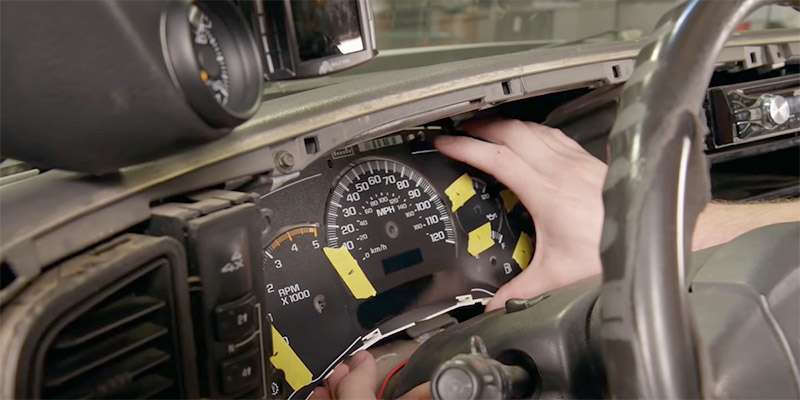A Ford F150 can enter limp mode due to various issues such as transmission problems, sensor failures or engine malfunctions. Faulty wiring or overheating may also trigger this safety feature.
Understanding why a Ford F150 might go into limp mode helps drivers to appropriately address potential issues and prevent further vehicle damage. Limp mode is a built-in protection strategy that the truck’s computer activates to mitigate the risk of harm when it detects a serious problem.
This reduced performance state allows you to drive your truck to a mechanic but limits speed and power to avoid straining the affected systems. This precaution is vital because it serves as an early warning sign that your vehicle requires immediate attention. Dealing with limp mode promptly can save you time and money while ensuring your safety on the road. Identifying the problem early, through diagnostic tools or professional assistance, is essential to getting your F150 back to full functionality.

Credit: www.reddit.com
Introduction To Limp Mode In Ford F-150
Welcome to our exploration of the Limp Mode in Ford F-150 trucks. Limp Mode is a crucial functionality designed to protect your engine when it senses trouble. In this blog post, we’ll delve into what kicks this feature into gear. Owners of the formidable Ford F-150 may encounter this safety mode. Understanding it can save you time and money.
Defining Limp Mode
Limp Mode is an electronic safeguard in vehicles, particularly in the Ford F-150.
- It’s an engine management feature.
- This mode restricts power to prevent damage.
- It helps the driver to “limp” to a service location.
Think of it as your truck’s way of saying, “I need help, but I can still take you to safety.”
Safety Mechanism Behind Limp Mode
The priority of Limp Mode is the safety of your vehicle’s systems. When something goes awry, it’s the truck’s instinct to protect itself and its passengers.
Below we outline how it safeguards your truck:
| Feature | Function |
|---|---|
| Engine Power Reduction | Minimizes strain on engine components |
| Transmission Control | Limits gear shifting to avoid further damage |
| Warning Signals | Activates dashboard lights to alert the driver |
In Limp Mode, your F-150 takes proactive steps to ensure you remain safe while preventing additional damage to the engine or transmission.
Common Triggers For Limp Mode Activation
When your Ford F150 suddenly loses power and feels unresponsive, it’s likely in limp mode. This mode is the truck’s clever way of protecting itself from further damage. Understanding what causes limp mode can save both time and money. Pinpointing the problem often involves looking at several common triggers.
Engine Faults
Limp mode in your F150 might spring from engine troubles. Here’s a quick rundown:
- Malfunctioning Sensors: Sensors that measure engine performance could fail.
- Overheating: Extreme engine heat can force the truck into limp mode.
- Low oil pressure: Insufficient oil pressure impacts engine health.
Transmission Issues
The transmission is key for power and gear shifts. Problems here can include:
| Issue | Impact |
|---|---|
| Fluid Levels: | Low or dirty fluid affects transmission operation. |
| Solenoid: | A faulty solenoid disrupts fluid flow. |
| Clutch: | Worn clutches lead to limp mode for protection. |
Throttle Problems
The throttle controls engine speed and power. Issues with this component might cause:
- Stuck Valves: Throttle body valves can get stuck, limiting power.
- Faulty Position Sensor: This messes with throttle control
- Wiring Problems: Damaged wires affect the throttle’s electronic signals.
Diagnostic Trouble Codes And Limp Mode
Diagnostic Trouble Codes (DTCs) are critical indicators of your Ford F150’s health. When your truck enters Limp Mode, it is signaling an issue that needs immediate attention. This safety feature limits your vehicle’s performance to prevent further damage. Understanding the codes and the link to Limp Mode can save you time and money on repairs.
Reading Error Codes
To begin troubleshooting, you’ll need to read the error codes stored in your truck’s computer. A diagnostic tool, often called an OBD-II scanner, is required. Plug the scanner into your F150’s OBD-II port. Follow the scanner’s instructions to retrieve the codes. These codes offer clues about the malfunction, leading to a more accurate diagnosis.
- Connect OBD-II scanner
- Power on scanner and vehicle
- Retrieve diagnostic trouble codes
- Note the codes for analysis
Link Between Codes And Limp Mode
Diagnostic Trouble Codes directly relate to the occurrence of Limp Mode. Each code corresponds to a specific issue within your F150. Common causes include transmission problems, faulty sensors, or engine malfunctions. Identifying the code helps pinpoint the issue, guiding you to the correct repair procedure and getting your truck out of Limp Mode.
| Error Code | Possible Cause | Related System |
|---|---|---|
| P0700 | Transmission Control System Malfunction | Transmission |
| P0102 | Mass Air Flow (MAF) Sensor Circuit Low | Engine |
| P0300 | Random/Multiple Cylinder Misfire Detected | Ignition System |
Interpret the codes and assess your truck’s needs. Common codes such as P0700 indicate transmission issues, while P0102 may suggest a problem with the Mass Air Flow sensor. Tackling these problems quickly can restore full power to your Ford F150.
Credit: www.f150gen14.com
Electrical Glitches Leading To Limp Mode
Electrical Glitches Leading to Limp Mode are amongst common issues that trip the Ford F150 into a protective state. Also known as ‘limp mode,’ this safety feature restricts power to prevent damage when the truck’s systems detect malfunctions. Let’s delve into the electrical irregularities that can cause this behavior.
Sensor Failures
Sensors are the eyes and ears of your Ford F150. They gather data on engine performance, temperature, and more. A faulty sensor sends incorrect signals to the truck’s computer, misleading it. Commonly affected sensors include:
- Throttle Position Sensor: Controls engine power.
- Oxygen Sensor: Monitors exhaust for optimal fuel mix.
- Transmission Sensor: Ensures smooth gear shifts.
When these sensors fail, your truck may enter limp mode to prevent potential engine or transmission damage.
Wiring Problems
The F150’s electrical system relies on a complex network of wires. Wiring problems can interrupt communication between the engine control unit and various components. This causes the system to react by switching into limp mode. Sources of wiring issues include:
| Issue | Impact |
|---|---|
| Corrosion | Disrupts electrical flow. |
| Short Circuits | Causes unexpected power surges. |
| Loose Connections | Creates intermittent signal loss. |
Damaged or loose wiring may necessitate a professional diagnosis to pinpoint the cause and remedy the problem, restoring full power to your F150.
External Factors Affecting F-150 Performance
Owners of the Ford F-150 may sometimes face a perplexing situation where their vehicle suddenly shifts into limp mode. This safety feature limits the truck’s speed to prevent further damage to the engine. Understanding the external factors that can trigger this can be crucial for both preventing and troubleshooting the issue.
Environmental Influences
The conditions in which you drive your F-150 can greatly impact its performance. Factors such as extreme temperatures, high altitudes, and humidity can affect the engine’s behavior, potentially causing it to go into limp mode. Be mindful of the following:
- Cold Weather: Freezing temperatures may thicken the engine oil, straining the engine.
- Heat: Overheating can occur on scorching days, triggering protective measures.
- Altitude: Higher elevations lead to thinner air, which might confuse the engine sensors.
Aftermarket Modifications
Modifying a Ford F-150 with aftermarket parts can enhance its aesthetics and performance, but sometimes these changes come with unintended consequences. Your truck’s computer system is calibrated to work with factory settings. Alterations such as these listed below can disrupt the system:
- Exhaust Systems: Modifying the exhaust can alter back pressure and sensor readings.
- Engine Tuners: These can change fuel mixtures and engine timing beyond safe limits.
- Cold Air Intakes: While they may increase airflow, they can also affect air sensor readings.
Always ensure that any modifications are compatible with your F-150 to prevent limp mode activations.
Steps To Resolve Limp Mode In Your F-150
Encountering limp mode in your Ford F150 can be puzzling. Your truck restricts power to prevent damage when it detects a fault. Let’s explore some effective steps to resolve this issue, ensuring you’re back on the road swiftly and safely.
Troubleshooting Basics
Identifying the cause is the first step to fixing limp mode. Consider these simple checks:
- Examine warning lights on your dashboard.
- Check for obvious signs of damage under the hood.
- Ensure your fluid levels are adequate—oil, coolant, transmission fluid.
These actions may reveal straightforward solutions:
| Issue | Action |
|---|---|
| Low Oil Level | Add oil to the required level |
| Coolant Warning | Refill the coolant reservoir |
| Transmission Fluid Low | Top up the transmission fluid |
Professional Diagnostic Techniques
When basic troubleshooting doesn’t resolve the issue, professional diagnostic tools come into play.
- Use an OBD-II scanner to read trouble codes.
- Analyze these codes for specific malfunctions in your truck.
- Schedule a service for a thorough inspection.
This approach offers a deeper insight into complex issues. A certified mechanic will:
- Perform advanced computer diagnostics.
- Test drive to assess performance in real conditions.
- Pinpoint and fix the underlying cause.

Credit: www.reddit.com
Frequently Asked Questions For What Causes A Ford F150 To Go Into Limp Mode
How Do I Get My Ford Truck Out Of Limp Mode?
To exit limp mode in a Ford truck, restart the engine. If persistent, check for error codes, resolve underlying issues, then reset the ECU or drive until the system resets itself. Consult a mechanic if problems continue.
What Sensors Can Cause Limp Mode?
Several sensors can trigger limp mode, including the oxygen sensor, throttle position sensor, mass airflow sensor, and transmission speed sensors. Faulty engine sensors or transmission sensors often lead to this protective measure.
What Causes A 2015 F150 To Go Into Limp Mode?
A 2015 F150 may enter limp mode due to several issues: transmission problems, faulty sensors, overheating, or damaged wiring harnesses. Regular maintenance can help prevent these triggers.
How Do I Take My Car Out Of Limp Mode?
Restart your car’s engine; this may temporarily deactivate limp mode. If the issue persists, check for dashboard error codes. Address any identified problems, such as sensor malfunctions or fluid levels, and reset the ECU if necessary. Consult a mechanic for persistent or unclear issues.
Conclusion
Understanding the triggers of limp mode in your Ford F150 is vital for uninterrupted performance. Timely detection and rectification of issues—from sensor malfunctions to transmission glitches—prevent costly repairs. Prioritize regular maintenance to ensure your F150 stays road-ready. Remember, a smooth ride begins with proactive vehicle care.
Stay informed, stay ahead.











